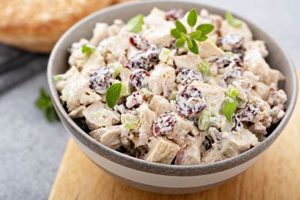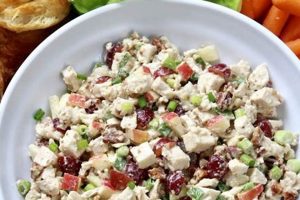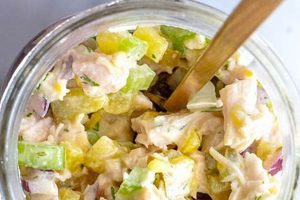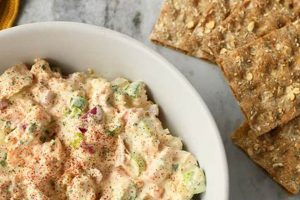A dish typically composed of cooked chicken, mayonnaise, and various other ingredients, this culinary creation offers a versatile base adaptable to diverse palates. Common additions include celery, onion, grapes, nuts, and seasonings like salt, pepper, and paprika. Variations may substitute Greek yogurt or sour cream for a lighter texture, or incorporate curry powder, Dijon mustard, or fresh herbs for enhanced flavor profiles. Examples range from classic preparations served on bread, crackers, or lettuce cups, to more elaborate presentations within croissants, avocado halves, or as fillings for wraps and sandwiches.
Its popularity stems from factors such as ease of preparation, affordability, and nutritional value. The dish provides a good source of protein and can be a healthy option when prepared with lean chicken and lighter ingredients. Historically, chicken salad emerged as a popular dish in the mid-19th century, coinciding with the rise of mayonnaise as a readily available condiment. Its evolution reflects changing culinary trends, with modern interpretations incorporating diverse cultural influences and dietary preferences.
Further exploration will delve into specific ingredient selections, preparation techniques, variations to suit dietary needs, and creative serving suggestions. Readers can expect to gain a deeper understanding of this adaptable and satisfying dish, from its fundamental components to its potential as a culinary centerpiece.
Tips for Exceptional Chicken Salad
Achieving a flavorful and well-balanced salad involves attention to several key factors, from ingredient selection and preparation to thoughtful flavor combinations and presentation.
Tip 1: Chicken Selection and Preparation: Opt for high-quality, cooked chicken. Rotisserie chicken offers convenience, while poaching or grilling boneless, skinless breasts allows for greater control over seasoning and moisture content. Shredding or dicing the chicken into uniform pieces ensures even distribution throughout the salad.
Tip 2: Mayonnaise Matters: Full-fat mayonnaise contributes richness and classic flavor. Reduced-fat or plain Greek yogurt can be substituted for a lighter version, but may impact the overall creaminess. Experimenting with flavored mayonnaises, such as olive oil or lemon-infused varieties, can add depth.
Tip 3: Balancing Texture: Incorporating textural elements elevates the sensory experience. Finely diced celery and onion provide crispness, while additions like chopped grapes, apples, or nuts introduce contrasting textures. Consider the interplay of soft and crunchy elements for optimal enjoyment.
Tip 4: Seasoning Strategies: Salt and pepper are essential for foundational seasoning. Fresh herbs, such as dill, chives, or parsley, can brighten the flavors. A touch of Dijon mustard adds tang, while curry powder or smoked paprika introduces complexity.
Tip 5: Chill Out: Chilling the prepared salad for at least 30 minutes allows the flavors to meld and enhances the overall experience. This step is particularly important when using fresh herbs or spices, as it allows their aromas to permeate the mixture.
Tip 6: Creative Serving Suggestions: While classic presentations on bread or crackers are always appreciated, exploring alternative serving methods can elevate the dish. Consider using lettuce cups, avocado halves, croissant rolls, or incorporating the salad into wraps or sandwiches.
Tip 7: Proportion and Balance: Achieving the right balance of ingredients is key. Avoid overusing any single component, ensuring that the chicken, mayonnaise, and other additions complement each other harmoniously. Taste and adjust seasonings as needed to achieve the desired flavor profile.
By following these guidelines, one can consistently create a delicious and satisfying salad suitable for a variety of occasions, from casual lunches to elegant gatherings. The ability to customize ingredients and flavors further enhances the versatility and appeal of this timeless dish.
The following section will explore variations of chicken salad recipes, catering to specific dietary preferences and culinary explorations.
1. Chicken (cooked, quality)
Cooked chicken serves as the foundational ingredient, directly impacting the overall quality and flavor profile. The choice of chicken and its preparation method significantly influence the final result. Employing pre-cooked options, such as rotisserie chicken, offers convenience, while cooking chicken specifically for the salad allows for greater control over seasoning and moisture content. Overcooked chicken can result in a dry, stringy texture, detracting from the desired creaminess and overall enjoyment. Conversely, undercooked chicken presents food safety concerns. Therefore, achieving the proper cooking temperature and employing appropriate cooling techniques are crucial.
The quality of the chicken itself also plays a vital role. Selecting higher-quality chicken typically translates to a more flavorful and enjoyable salad. Consider factors such as the chicken’s source, breed, and diet. Free-range or organic options often exhibit superior flavor profiles compared to conventionally raised chickens. Furthermore, the cut of chicken utilized influences the final texture. Breast meat offers a leaner, more delicate texture, while thigh meat contributes richness and a more robust flavor. The specific cut chosen should align with individual preferences and the desired outcome.
Proper handling and storage of cooked chicken are essential for food safety. Refrigerate cooked chicken promptly and maintain appropriate temperatures to prevent bacterial growth. Adhering to safe food handling practices ensures a safe and enjoyable culinary experience. The careful selection and preparation of cooked, quality chicken constitute the critical first step in crafting a successful and satisfying salad. This foundational element sets the stage for a delightful culinary creation, underscoring its importance in the overall recipe.
2. Creamy Base (mayonnaise, yogurt)
The creamy base forms the heart of a creamy chicken salad recipe, binding the ingredients and contributing significantly to the overall texture and flavor profile. The choice of creamy base, primarily mayonnaise or yogurt, directly influences the richness, tanginess, and caloric content of the final product. Understanding the nuances of each option allows for informed decisions tailored to individual preferences and dietary considerations.
- Mayonnaise: The Classic Choice
Traditional recipes rely on mayonnaise for its rich, emulsified texture and characteristic tang. Full-fat mayonnaise provides the quintessential creamy experience, while reduced-fat versions offer a lighter alternative with potentially compromised flavor and texture. The type of oil used in the mayonnaise also influences the final taste; for instance, olive oil mayonnaise imparts a subtle fruity note. The amount of mayonnaise used dictates the salad’s overall richness and consistency.
- Yogurt: A Lighter Alternative
Plain yogurt, particularly Greek yogurt, offers a tangier and lower-fat alternative to mayonnaise. Its higher protein content contributes to a more substantial texture, while its lower fat content aligns with health-conscious preferences. Substituting yogurt for mayonnaise, either partially or fully, results in a lighter, brighter flavor profile. The consistency of yogurt-based salads tends to be slightly looser than those made with mayonnaise.
- Hybrid Approach: Combining Mayonnaise and Yogurt
Combining mayonnaise and yogurt offers a balanced approach, capitalizing on the strengths of each ingredient. This method allows for controlled richness and tanginess while reducing overall fat content. The ratio of mayonnaise to yogurt can be adjusted to achieve the desired flavor and consistency. This flexibility allows for customization based on individual preferences.
- Flavor Infusions: Elevating the Creamy Base
Incorporating additional flavors directly into the creamy base elevates the overall complexity of the salad. Adding ingredients like Dijon mustard, lemon juice, or fresh herbs directly into the mayonnaise or yogurt enhances the flavor profile before it even touches the chicken or other ingredients. This pre-emptive flavor infusion ensures a more homogenous and well-integrated taste experience.
The selection and preparation of the creamy base represent a pivotal step in crafting a creamy chicken salad recipe. Careful consideration of the type of mayonnaise or yogurt, the potential for combining these elements, and the incorporation of additional flavors allows for a customized and satisfying outcome. This crucial component sets the stage for a delightful culinary experience, directly influencing the final flavor, texture, and overall enjoyment of the dish.
3. Flavor Enhancers (herbs, spices)
Flavor enhancers play a crucial role in elevating creamy chicken salad beyond a simple combination of ingredients. Judicious use of herbs and spices transforms the dish, adding depth, complexity, and a unique signature. The selection and balance of these flavor components significantly impact the overall sensory experience, offering a wide range of possibilities for customization and culinary exploration.
- Fresh Herbs: Brightening the Palate
Fresh herbs contribute vibrancy and aromatic complexity. Dill, parsley, chives, and tarragon are popular choices, each imparting a distinct character. Dill offers a slightly tangy, grassy note, while parsley provides a clean, fresh flavor. Chives contribute a mild onion flavor, and tarragon introduces a subtle anise-like essence. The quantity of fresh herbs used should be carefully balanced to complement the other ingredients without overpowering the overall flavor profile. Adding herbs towards the end of the preparation process preserves their delicate flavors and vibrant green color.
- Dried Spices: Layering Complexity
Dried spices offer concentrated flavors and extended shelf life. Paprika, curry powder, cumin, and garlic powder are common additions. Paprika adds a subtle smokiness and vibrant color, while curry powder introduces a blend of warm, aromatic spices. Cumin provides an earthy, slightly bitter note, and garlic powder contributes a savory depth. Dried spices should be used sparingly, as their concentrated flavors can easily dominate the dish. Blooming dried spices in a small amount of oil before adding them to the salad can enhance their aromatic qualities.
- Spice Blends: Harmonious Combinations
Pre-mixed spice blends offer convenient flavor solutions. Herbes de Provence, a classic French blend, combines herbs like thyme, rosemary, and oregano, offering a Mediterranean touch. Garam masala, an Indian spice blend, introduces warm, complex flavors. Using pre-mixed blends simplifies the seasoning process while ensuring a balanced and harmonious flavor profile. Experimenting with different spice blends can introduce unique and exciting dimensions to the salad.
- Balancing Flavors: A Delicate Dance
The key to successful flavor enhancement lies in achieving a harmonious balance. No single herb or spice should dominate the overall flavor profile. Start with small amounts and taste frequently, adjusting the seasoning as needed. The interplay of fresh herbs, dried spices, and other flavoring agents, such as lemon juice or Dijon mustard, contributes to a multi-layered and nuanced sensory experience. Consider the overall flavor profile desired and select herbs and spices that complement each other and the other ingredients in the salad.
The thoughtful incorporation of flavor enhancers elevates creamy chicken salad from a simple dish to a culinary creation. The careful selection and balance of fresh herbs, dried spices, and spice blends contribute depth, complexity, and a unique signature. By understanding the nuances of each flavor component and employing a judicious approach, one can create a truly exceptional and personalized culinary experience.
4. Textural Variety (celery, nuts)
Textural variety constitutes a critical element in a well-executed creamy chicken salad recipe. The interplay of contrasting textures elevates the sensory experience beyond the basic flavors of the core ingredients. Incorporating elements that provide crunch, crispness, or chewiness enhances the overall enjoyment and adds a dimension of complexity often overlooked. This exploration delves into the specific contributions of various textural components and their impact on the final product.
- Celery: The Classic Crisp
Celery offers a familiar and refreshing crunch, acting as a counterpoint to the creamy base. Its subtle, slightly vegetal flavor complements the chicken and other ingredients without overpowering the overall taste profile. The crisp texture of celery adds a lightness and vibrancy, preventing the salad from becoming overly dense or heavy. Finely diced celery ensures even distribution and a pleasant textural contrast in every bite.
- Nuts: Adding Depth and Complexity
Nuts contribute both textural complexity and flavor depth. Options such as walnuts, pecans, almonds, or cashews introduce a satisfying crunch and a range of flavor profiles, from buttery to earthy. Toasted nuts further enhance their inherent flavors and provide a more pronounced textural contrast. The choice of nut should complement the other ingredients and the overall flavor profile desired. Chopping nuts into smaller pieces ensures even distribution and prevents them from overpowering the salad. The fat content in nuts also contributes to a richer, more satisfying mouthfeel.
- Fruits: A Touch of Sweetness and Juiciness
Incorporating fruits introduces an element of sweetness and juiciness, further diversifying the textural profile. Grapes, apples, or dried cranberries offer contrasting textures and flavors that complement the savory elements of the salad. The choice of fruit should be considered in relation to the overall flavor profile desired. For instance, grapes provide a burst of sweetness and a slightly firm texture, while apples offer a crisp, tart counterpoint. Dried cranberries contribute a chewy texture and concentrated sweetness.
- Seeds: Subtle Crunch and Nutritional Boost
Seeds, such as sunflower seeds or pumpkin seeds, offer a subtle crunch and a nutritional boost. Their relatively neutral flavor allows them to blend seamlessly with the other ingredients, while their small size ensures even distribution throughout the salad. Seeds provide a delicate textural contrast without overpowering the overall flavor profile. They also contribute healthy fats and other beneficial nutrients.
The strategic incorporation of textural elements elevates creamy chicken salad from a simple dish to a more complex and satisfying culinary experience. The interplay of creamy, crunchy, crisp, and chewy elements creates a dynamic sensory experience. By thoughtfully considering the contributions of each ingredient and the overall balance of textures, one can craft a truly exceptional and memorable salad.
5. Serving Style (bread, lettuce cups)
The manner in which creamy chicken salad is presented significantly impacts the overall dining experience. Serving style influences not only the perceived aesthetic appeal but also the practicality and perceived flavor profile. Consideration of the serving vessel complements the carefully crafted flavors and textures of the salad itself, transforming a simple dish into a curated culinary experience. The following explores various serving styles and their respective contributions to the enjoyment of creamy chicken salad.
- Classic Bread: Sandwiches and Beyond
Bread serves as a traditional and versatile vehicle for creamy chicken salad. Options range from simple sliced white bread to crusty sourdough or whole-wheat varieties. The choice of bread influences the textural contrast and flavor profile. A soft, buttery croissant complements the creamy salad, while a robust multigrain bread offers a more substantial and texturally diverse experience. Beyond sandwiches, bread can be utilized in various formats, such as open-faced tartines or scooped-out rolls, offering versatility in presentation.
- Lettuce Cups: A Fresh and Light Alternative
Lettuce cups provide a refreshing and lighter alternative to bread, aligning with health-conscious preferences. Large, sturdy lettuce leaves, such as romaine or butter lettuce, form convenient vessels for the salad. This option reduces carbohydrate intake while adding a crisp, fresh element. The coolness of the lettuce complements the creamy filling, creating a contrasting sensory experience. Lettuce cups offer a visually appealing and easy-to-handle serving method, particularly suitable for casual gatherings or outdoor dining.
- Crackers and Crostini: Elegant Simplicity
Crackers or crostini offer a simple yet elegant serving platform. The crisp, crunchy texture of crackers provides a delightful contrast to the creamy salad. A variety of cracker flavors, from plain to herbed or seeded, further complements the flavor profile. Crostini, toasted slices of baguette, offer a more substantial base with a slightly charred flavor. This serving style lends itself well to appetizers, buffets, or smaller portions, allowing for easy handling and portion control.
- Creative Vessels: Expanding the Possibilities
Beyond traditional options, exploring creative serving vessels can elevate the presentation and overall experience. Avocado halves, hollowed-out tomatoes, or bell peppers create visually appealing and flavorful presentations. These options introduce additional textures and flavors that complement the chicken salad. For example, the creamy richness of avocado harmonizes with the salad, while the sweetness of bell peppers adds a contrasting note. Such creative presentations enhance the visual appeal and offer a unique dining experience.
The chosen serving style for creamy chicken salad plays a significant role in shaping the overall culinary experience. From classic bread to innovative vessels, each option contributes distinct textural and flavor elements. Careful consideration of the serving style allows for customization and enhancement, transforming a simple dish into a thoughtfully presented and thoroughly enjoyable culinary creation.
Frequently Asked Questions
This section addresses common inquiries regarding the preparation and enjoyment of this versatile dish. Clarity on these points ensures a successful culinary outcome.
Question 1: How long can this dish be stored safely?
Properly stored in an airtight container in the refrigerator, it typically remains safe for consumption for three to five days. Beyond this timeframe, the risk of bacterial growth increases significantly.
Question 2: What are suitable substitutions for mayonnaise?
Plain Greek yogurt or avocado offer healthier alternatives to mayonnaise, impacting flavor and texture. Sour cream or a combination of yogurt and mayonnaise can also be utilized.
Question 3: Can one freeze the salad successfully?
Freezing is not generally recommended. The mayonnaise-based dressing can separate upon thawing, resulting in an undesirable texture. Freezing may also negatively impact the flavors of the other ingredients.
Question 4: How can one reduce the overall fat content?
Using lean chicken breast, incorporating more fruits and vegetables, and opting for low-fat mayonnaise or plain Greek yogurt significantly reduces fat content. Portion control also contributes to managing overall intake.
Question 5: What are some variations to consider?
Adding curry powder creates a curried chicken salad. Incorporating grapes and pecans offers a classic Waldorf-style variation. Using chopped apples and cranberries provides a sweet and tart twist. Numerous variations cater to diverse palates.
Question 6: How can one ensure food safety during preparation?
Washing hands thoroughly, using clean utensils and surfaces, maintaining proper refrigeration temperatures for ingredients, and ensuring the chicken reaches a safe internal temperature are crucial for preventing foodborne illnesses.
Understanding these aspects ensures the safe preparation and enjoyable consumption. Prioritizing food safety and proper storage practices contributes to a positive culinary experience.
The following section will provide a selection of curated recipes, offering specific ingredient lists and step-by-step instructions.
Creamy Chicken Salad Recipe
This exploration has delved into the multifaceted aspects of creamy chicken salad recipes, from the foundational elements of ingredient selection and preparation to the nuances of flavor enhancement and presentation. Key considerations include the choice of chicken, the selection and balance of creamy base components, the strategic incorporation of textural variety, and the thoughtful application of herbs, spices, and other flavor enhancers. Serving styles, ranging from classic bread to innovative vessels, further contribute to the overall dining experience. Proper food safety practices and storage techniques ensure both enjoyment and well-being.
Creamy chicken salad recipes offer a canvas for culinary creativity, adaptable to diverse palates and dietary preferences. The potential for customization, from classic preparations to innovative interpretations, ensures its enduring appeal. By understanding the underlying principles and employing a thoughtful approach, one can consistently create a dish that satisfies both the novice cook and the seasoned gourmand. Further exploration and experimentation promise continued culinary delight and discovery within the realm of this versatile and timeless classic.






